Report on Accounting Treatment of Contingent Liabilities for Beachlife
VerifiedAdded on 2020/05/28
|6
|1215
|69
Report
AI Summary
This report, prepared by Magenta and Associates for Beachlife Ltd, addresses the accounting treatment of contingent liabilities and provisions. It begins by defining contingent liabilities and referencing AASB 137, emphasizing the need for current responsibility and probable economic outflow. The report distinguishes between contingent liabilities, which are disclosed in notes, and provisions, which are recognized in the statements. The report provides specific recommendations for Beachlife Ltd, advising the company to disclose its liability related to pending legal claims in the notes, based on the legal advisor's prediction of a 30% chance of liability. It calculates the amount to be disclosed as $42 million. Furthermore, the report addresses an agreement with Alpine Ltd, recommending that Beachlife Ltd account for $180,000 as sales, $15,000 as provisions, and disclose a contingent liability of $27,000 in the notes, considering the maintenance agreement and potential refund. The report concludes by offering further assistance if needed.
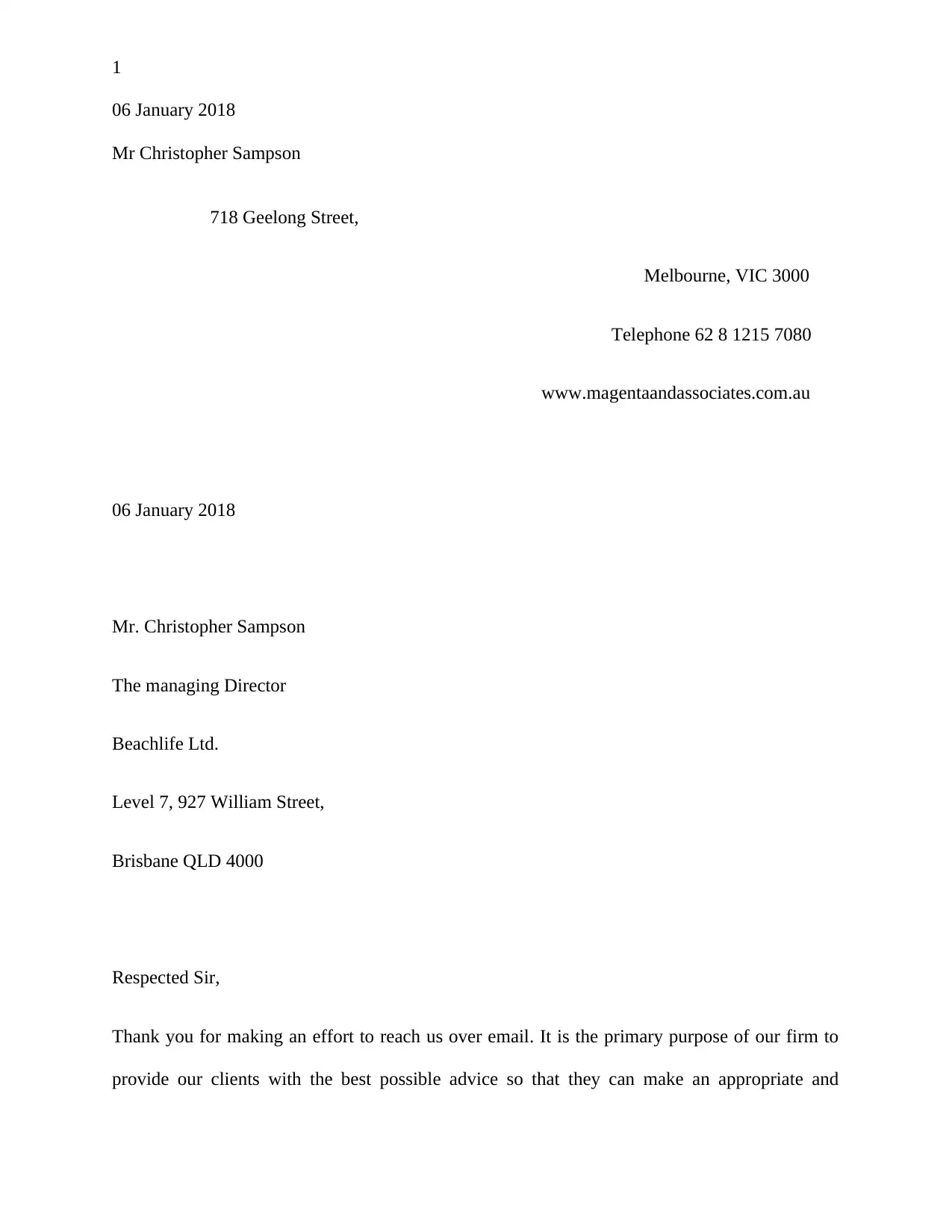
1
06 January 2018
Mr Christopher Sampson
718 Geelong Street,
Melbourne, VIC 3000
Telephone 62 8 1215 7080
www.magentaandassociates.com.au
06 January 2018
Mr. Christopher Sampson
The managing Director
Beachlife Ltd.
Level 7, 927 William Street,
Brisbane QLD 4000
Respected Sir,
Thank you for making an effort to reach us over email. It is the primary purpose of our firm to
provide our clients with the best possible advice so that they can make an appropriate and
06 January 2018
Mr Christopher Sampson
718 Geelong Street,
Melbourne, VIC 3000
Telephone 62 8 1215 7080
www.magentaandassociates.com.au
06 January 2018
Mr. Christopher Sampson
The managing Director
Beachlife Ltd.
Level 7, 927 William Street,
Brisbane QLD 4000
Respected Sir,
Thank you for making an effort to reach us over email. It is the primary purpose of our firm to
provide our clients with the best possible advice so that they can make an appropriate and
Paraphrase This Document
Need a fresh take? Get an instant paraphrase of this document with our AI Paraphraser
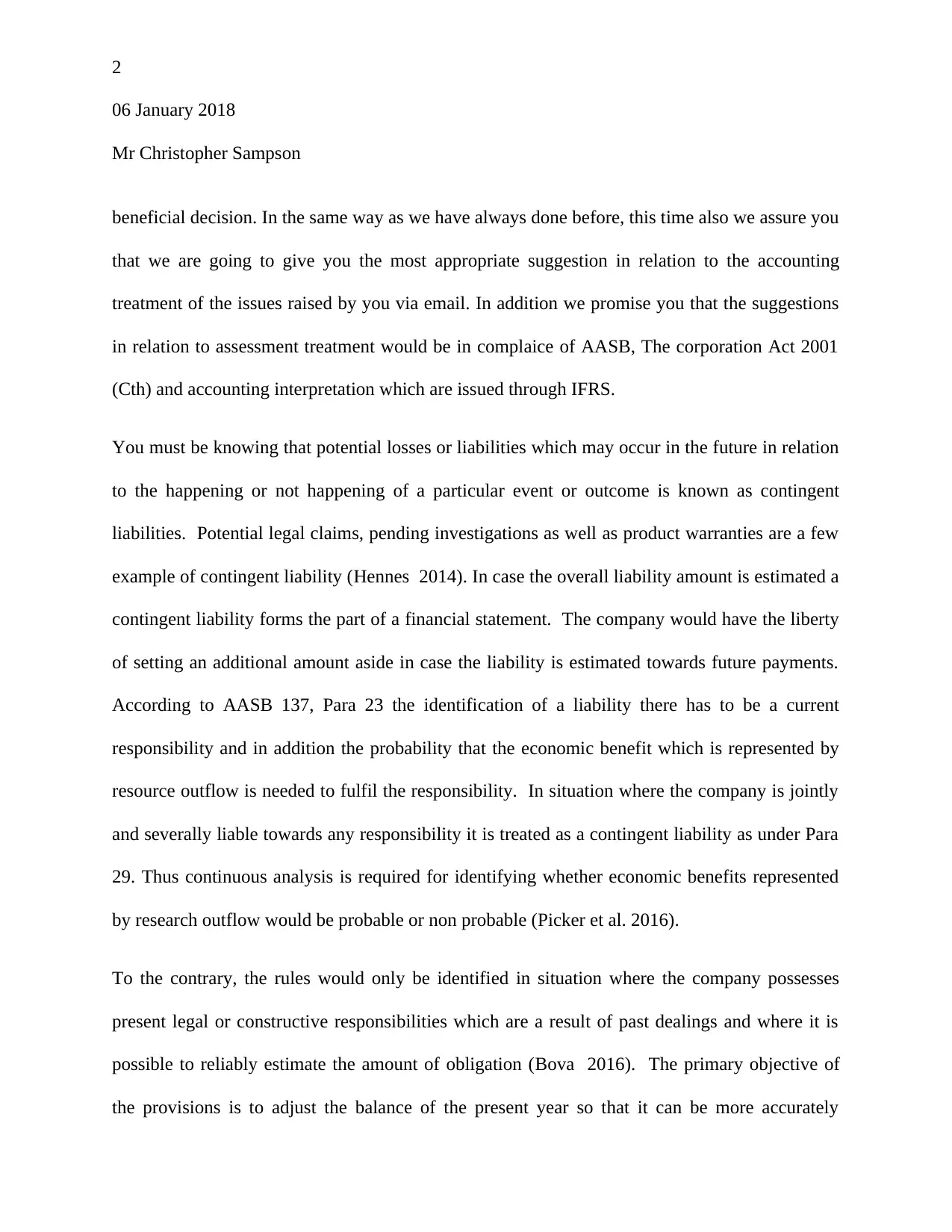
2
06 January 2018
Mr Christopher Sampson
beneficial decision. In the same way as we have always done before, this time also we assure you
that we are going to give you the most appropriate suggestion in relation to the accounting
treatment of the issues raised by you via email. In addition we promise you that the suggestions
in relation to assessment treatment would be in complaice of AASB, The corporation Act 2001
(Cth) and accounting interpretation which are issued through IFRS.
You must be knowing that potential losses or liabilities which may occur in the future in relation
to the happening or not happening of a particular event or outcome is known as contingent
liabilities. Potential legal claims, pending investigations as well as product warranties are a few
example of contingent liability (Hennes 2014). In case the overall liability amount is estimated a
contingent liability forms the part of a financial statement. The company would have the liberty
of setting an additional amount aside in case the liability is estimated towards future payments.
According to AASB 137, Para 23 the identification of a liability there has to be a current
responsibility and in addition the probability that the economic benefit which is represented by
resource outflow is needed to fulfil the responsibility. In situation where the company is jointly
and severally liable towards any responsibility it is treated as a contingent liability as under Para
29. Thus continuous analysis is required for identifying whether economic benefits represented
by research outflow would be probable or non probable (Picker et al. 2016).
To the contrary, the rules would only be identified in situation where the company possesses
present legal or constructive responsibilities which are a result of past dealings and where it is
possible to reliably estimate the amount of obligation (Bova 2016). The primary objective of
the provisions is to adjust the balance of the present year so that it can be more accurately
06 January 2018
Mr Christopher Sampson
beneficial decision. In the same way as we have always done before, this time also we assure you
that we are going to give you the most appropriate suggestion in relation to the accounting
treatment of the issues raised by you via email. In addition we promise you that the suggestions
in relation to assessment treatment would be in complaice of AASB, The corporation Act 2001
(Cth) and accounting interpretation which are issued through IFRS.
You must be knowing that potential losses or liabilities which may occur in the future in relation
to the happening or not happening of a particular event or outcome is known as contingent
liabilities. Potential legal claims, pending investigations as well as product warranties are a few
example of contingent liability (Hennes 2014). In case the overall liability amount is estimated a
contingent liability forms the part of a financial statement. The company would have the liberty
of setting an additional amount aside in case the liability is estimated towards future payments.
According to AASB 137, Para 23 the identification of a liability there has to be a current
responsibility and in addition the probability that the economic benefit which is represented by
resource outflow is needed to fulfil the responsibility. In situation where the company is jointly
and severally liable towards any responsibility it is treated as a contingent liability as under Para
29. Thus continuous analysis is required for identifying whether economic benefits represented
by research outflow would be probable or non probable (Picker et al. 2016).
To the contrary, the rules would only be identified in situation where the company possesses
present legal or constructive responsibilities which are a result of past dealings and where it is
possible to reliably estimate the amount of obligation (Bova 2016). The primary objective of
the provisions is to adjust the balance of the present year so that it can be more accurately
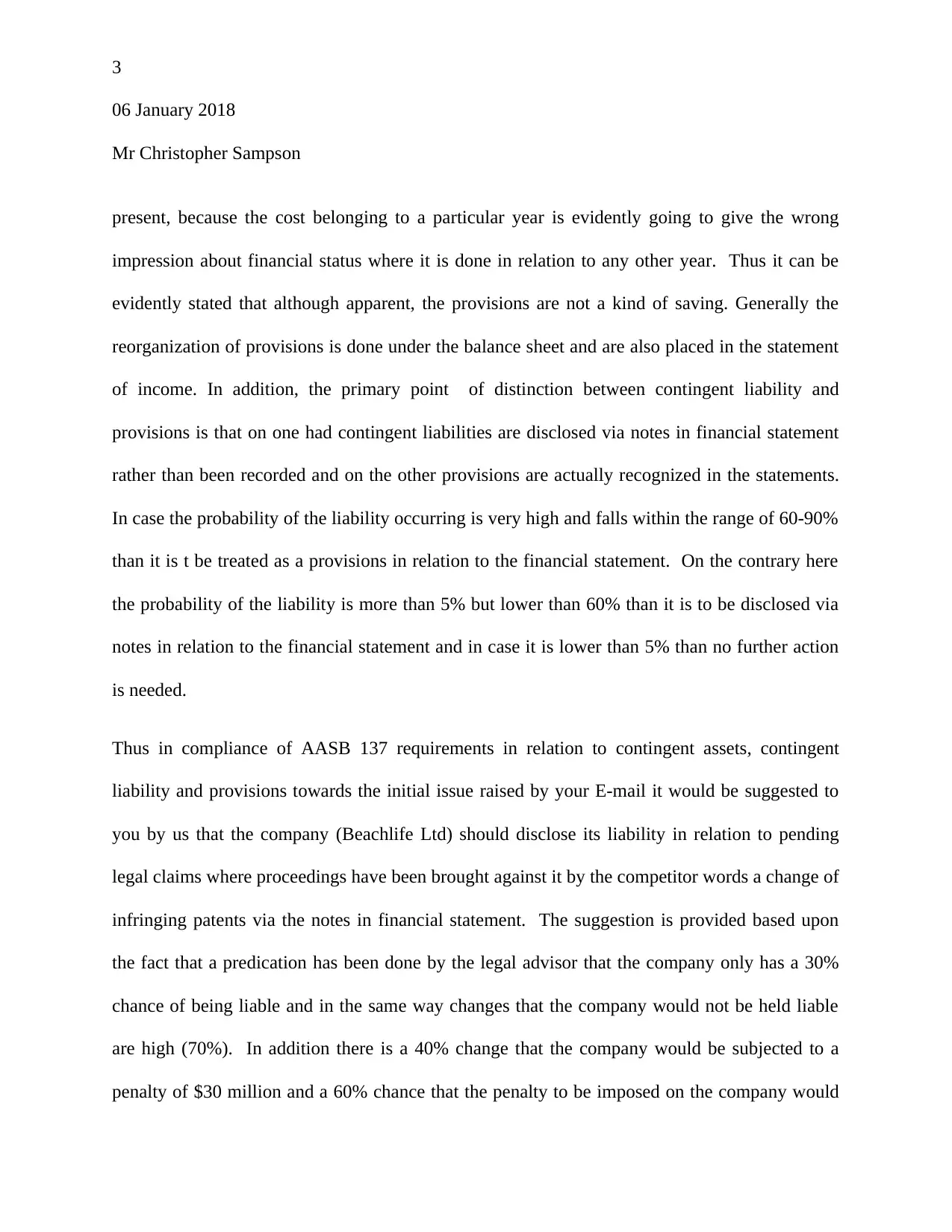
3
06 January 2018
Mr Christopher Sampson
present, because the cost belonging to a particular year is evidently going to give the wrong
impression about financial status where it is done in relation to any other year. Thus it can be
evidently stated that although apparent, the provisions are not a kind of saving. Generally the
reorganization of provisions is done under the balance sheet and are also placed in the statement
of income. In addition, the primary point of distinction between contingent liability and
provisions is that on one had contingent liabilities are disclosed via notes in financial statement
rather than been recorded and on the other provisions are actually recognized in the statements.
In case the probability of the liability occurring is very high and falls within the range of 60-90%
than it is t be treated as a provisions in relation to the financial statement. On the contrary here
the probability of the liability is more than 5% but lower than 60% than it is to be disclosed via
notes in relation to the financial statement and in case it is lower than 5% than no further action
is needed.
Thus in compliance of AASB 137 requirements in relation to contingent assets, contingent
liability and provisions towards the initial issue raised by your E-mail it would be suggested to
you by us that the company (Beachlife Ltd) should disclose its liability in relation to pending
legal claims where proceedings have been brought against it by the competitor words a change of
infringing patents via the notes in financial statement. The suggestion is provided based upon
the fact that a predication has been done by the legal advisor that the company only has a 30%
chance of being liable and in the same way changes that the company would not be held liable
are high (70%). In addition there is a 40% change that the company would be subjected to a
penalty of $30 million and a 60% chance that the penalty to be imposed on the company would
06 January 2018
Mr Christopher Sampson
present, because the cost belonging to a particular year is evidently going to give the wrong
impression about financial status where it is done in relation to any other year. Thus it can be
evidently stated that although apparent, the provisions are not a kind of saving. Generally the
reorganization of provisions is done under the balance sheet and are also placed in the statement
of income. In addition, the primary point of distinction between contingent liability and
provisions is that on one had contingent liabilities are disclosed via notes in financial statement
rather than been recorded and on the other provisions are actually recognized in the statements.
In case the probability of the liability occurring is very high and falls within the range of 60-90%
than it is t be treated as a provisions in relation to the financial statement. On the contrary here
the probability of the liability is more than 5% but lower than 60% than it is to be disclosed via
notes in relation to the financial statement and in case it is lower than 5% than no further action
is needed.
Thus in compliance of AASB 137 requirements in relation to contingent assets, contingent
liability and provisions towards the initial issue raised by your E-mail it would be suggested to
you by us that the company (Beachlife Ltd) should disclose its liability in relation to pending
legal claims where proceedings have been brought against it by the competitor words a change of
infringing patents via the notes in financial statement. The suggestion is provided based upon
the fact that a predication has been done by the legal advisor that the company only has a 30%
chance of being liable and in the same way changes that the company would not be held liable
are high (70%). In addition there is a 40% change that the company would be subjected to a
penalty of $30 million and a 60% chance that the penalty to be imposed on the company would
⊘ This is a preview!⊘
Do you want full access?
Subscribe today to unlock all pages.

Trusted by 1+ million students worldwide
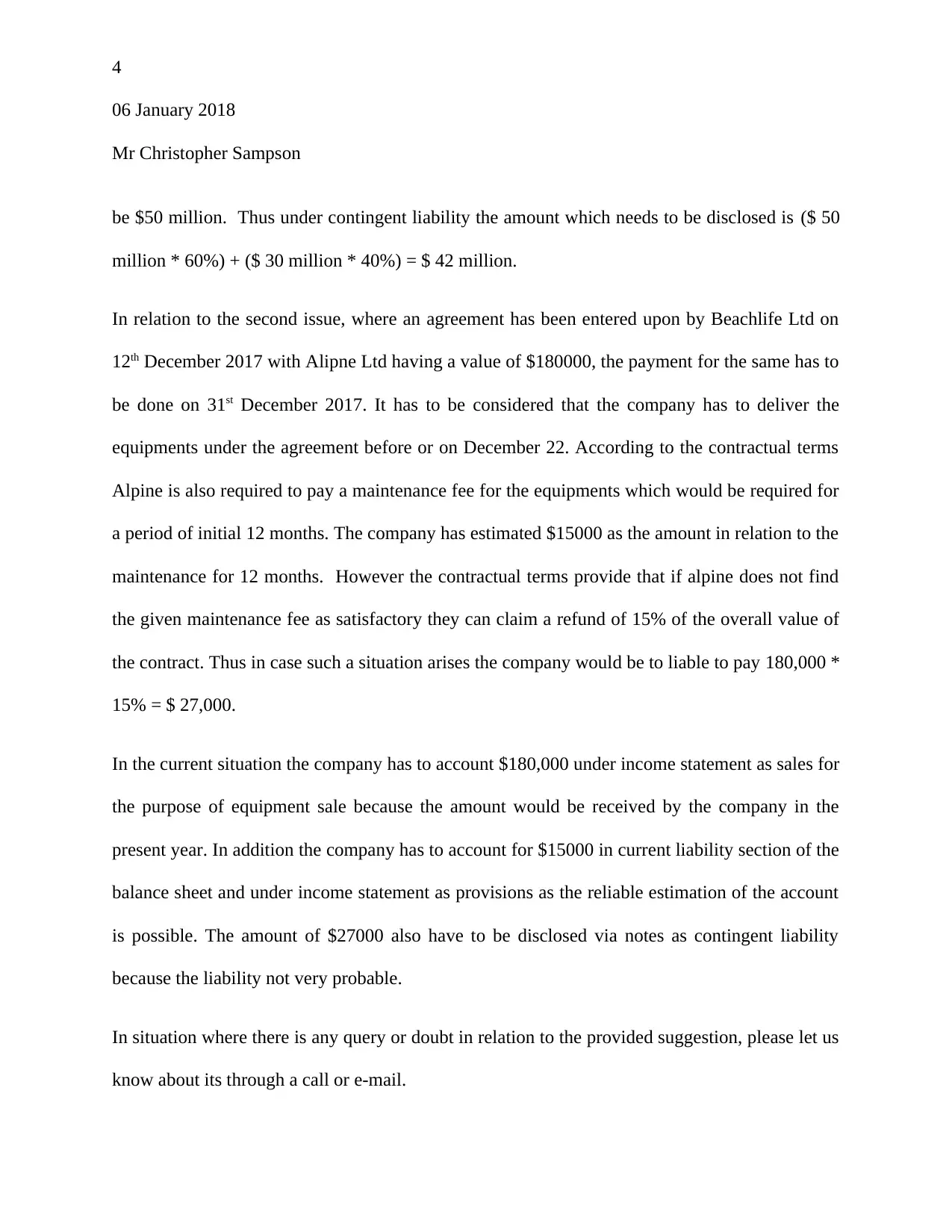
4
06 January 2018
Mr Christopher Sampson
be $50 million. Thus under contingent liability the amount which needs to be disclosed is ($ 50
million * 60%) + ($ 30 million * 40%) = $ 42 million.
In relation to the second issue, where an agreement has been entered upon by Beachlife Ltd on
12th December 2017 with Alipne Ltd having a value of $180000, the payment for the same has to
be done on 31st December 2017. It has to be considered that the company has to deliver the
equipments under the agreement before or on December 22. According to the contractual terms
Alpine is also required to pay a maintenance fee for the equipments which would be required for
a period of initial 12 months. The company has estimated $15000 as the amount in relation to the
maintenance for 12 months. However the contractual terms provide that if alpine does not find
the given maintenance fee as satisfactory they can claim a refund of 15% of the overall value of
the contract. Thus in case such a situation arises the company would be to liable to pay 180,000 *
15% = $ 27,000.
In the current situation the company has to account $180,000 under income statement as sales for
the purpose of equipment sale because the amount would be received by the company in the
present year. In addition the company has to account for $15000 in current liability section of the
balance sheet and under income statement as provisions as the reliable estimation of the account
is possible. The amount of $27000 also have to be disclosed via notes as contingent liability
because the liability not very probable.
In situation where there is any query or doubt in relation to the provided suggestion, please let us
know about its through a call or e-mail.
06 January 2018
Mr Christopher Sampson
be $50 million. Thus under contingent liability the amount which needs to be disclosed is ($ 50
million * 60%) + ($ 30 million * 40%) = $ 42 million.
In relation to the second issue, where an agreement has been entered upon by Beachlife Ltd on
12th December 2017 with Alipne Ltd having a value of $180000, the payment for the same has to
be done on 31st December 2017. It has to be considered that the company has to deliver the
equipments under the agreement before or on December 22. According to the contractual terms
Alpine is also required to pay a maintenance fee for the equipments which would be required for
a period of initial 12 months. The company has estimated $15000 as the amount in relation to the
maintenance for 12 months. However the contractual terms provide that if alpine does not find
the given maintenance fee as satisfactory they can claim a refund of 15% of the overall value of
the contract. Thus in case such a situation arises the company would be to liable to pay 180,000 *
15% = $ 27,000.
In the current situation the company has to account $180,000 under income statement as sales for
the purpose of equipment sale because the amount would be received by the company in the
present year. In addition the company has to account for $15000 in current liability section of the
balance sheet and under income statement as provisions as the reliable estimation of the account
is possible. The amount of $27000 also have to be disclosed via notes as contingent liability
because the liability not very probable.
In situation where there is any query or doubt in relation to the provided suggestion, please let us
know about its through a call or e-mail.
Paraphrase This Document
Need a fresh take? Get an instant paraphrase of this document with our AI Paraphraser
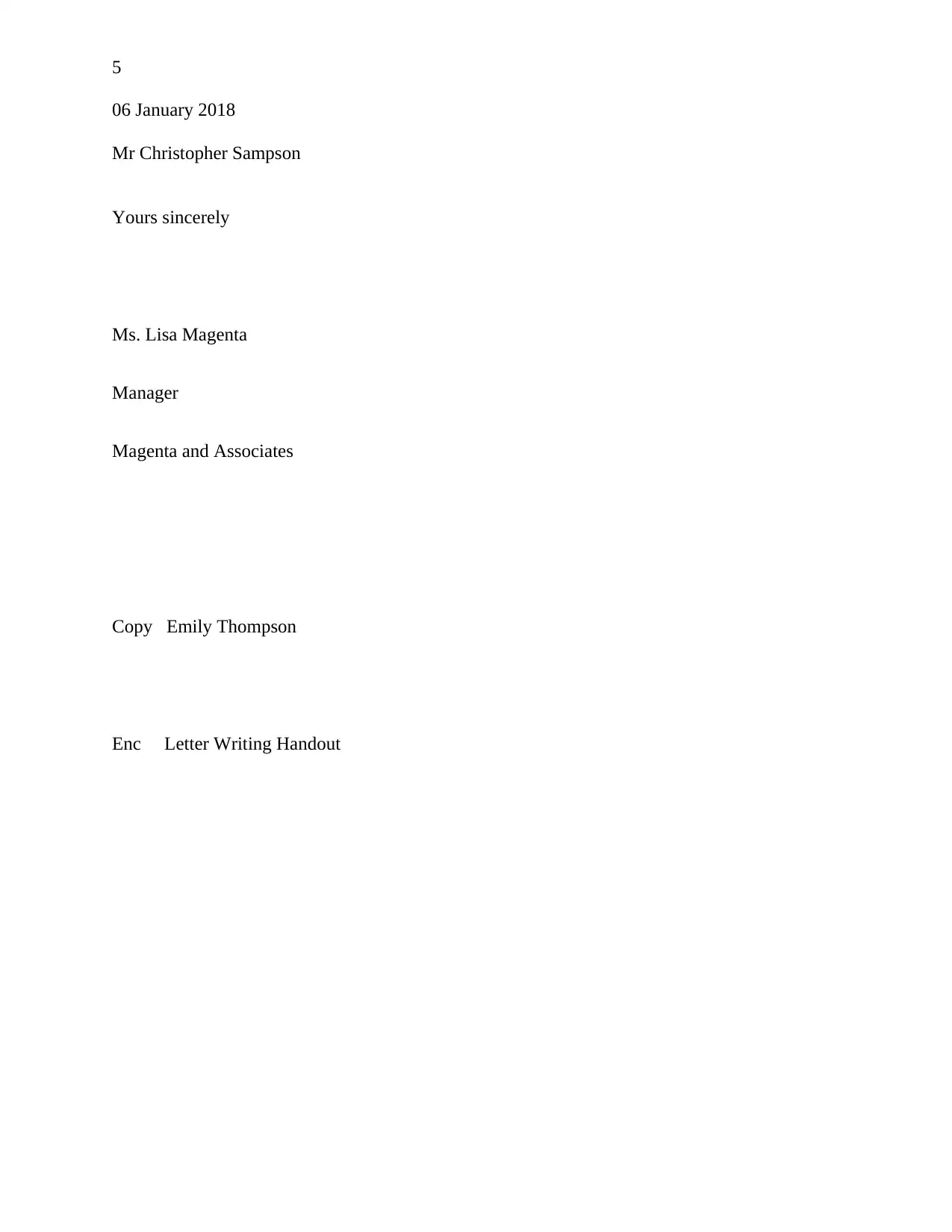
5
06 January 2018
Mr Christopher Sampson
Yours sincerely
Ms. Lisa Magenta
Manager
Magenta and Associates
Copy Emily Thompson
Enc Letter Writing Handout
06 January 2018
Mr Christopher Sampson
Yours sincerely
Ms. Lisa Magenta
Manager
Magenta and Associates
Copy Emily Thompson
Enc Letter Writing Handout
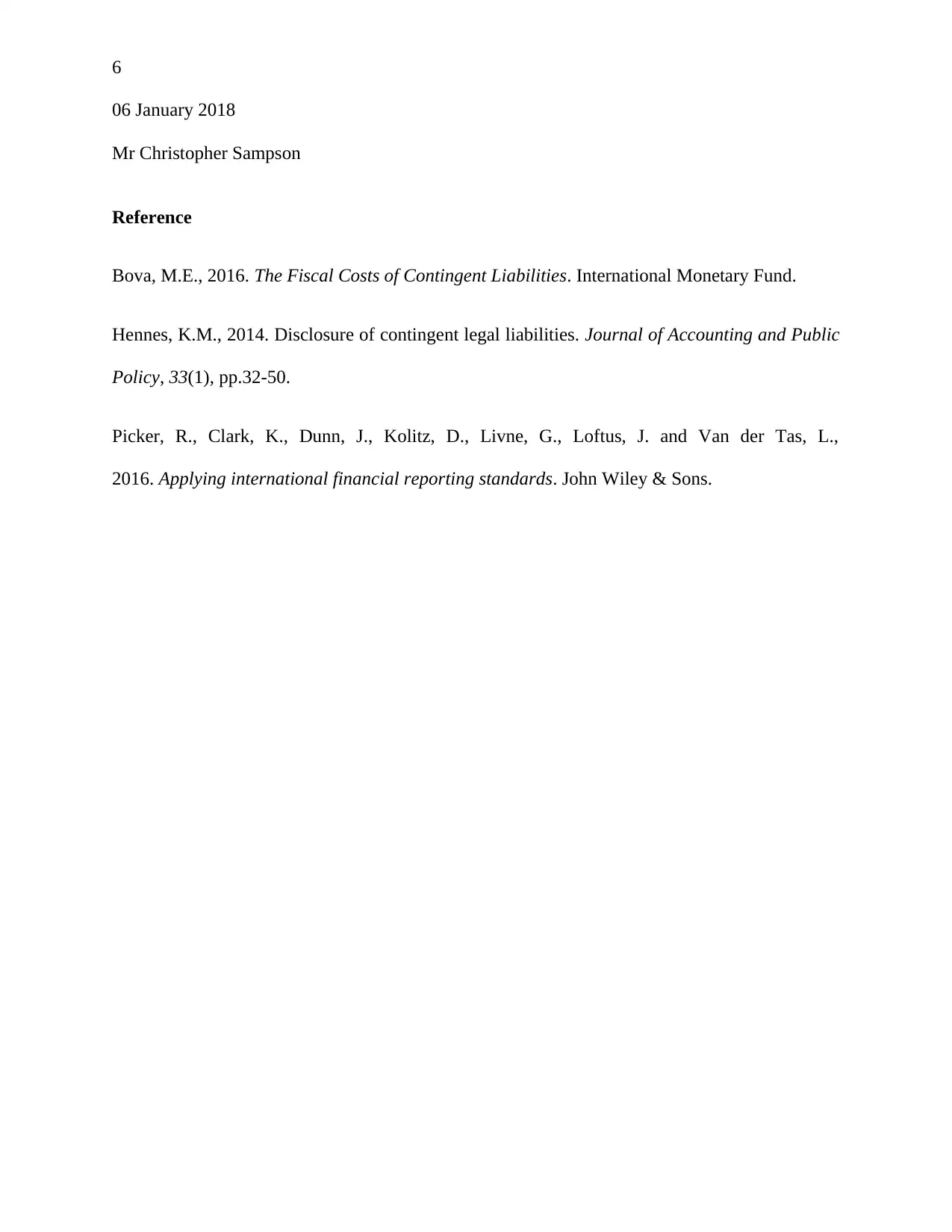
6
06 January 2018
Mr Christopher Sampson
Reference
Bova, M.E., 2016. The Fiscal Costs of Contingent Liabilities. International Monetary Fund.
Hennes, K.M., 2014. Disclosure of contingent legal liabilities. Journal of Accounting and Public
Policy, 33(1), pp.32-50.
Picker, R., Clark, K., Dunn, J., Kolitz, D., Livne, G., Loftus, J. and Van der Tas, L.,
2016. Applying international financial reporting standards. John Wiley & Sons.
06 January 2018
Mr Christopher Sampson
Reference
Bova, M.E., 2016. The Fiscal Costs of Contingent Liabilities. International Monetary Fund.
Hennes, K.M., 2014. Disclosure of contingent legal liabilities. Journal of Accounting and Public
Policy, 33(1), pp.32-50.
Picker, R., Clark, K., Dunn, J., Kolitz, D., Livne, G., Loftus, J. and Van der Tas, L.,
2016. Applying international financial reporting standards. John Wiley & Sons.
⊘ This is a preview!⊘
Do you want full access?
Subscribe today to unlock all pages.

Trusted by 1+ million students worldwide
1 out of 6
Related Documents
Your All-in-One AI-Powered Toolkit for Academic Success.
+13062052269
info@desklib.com
Available 24*7 on WhatsApp / Email
![[object Object]](/_next/static/media/star-bottom.7253800d.svg)
Unlock your academic potential
Copyright © 2020–2025 A2Z Services. All Rights Reserved. Developed and managed by ZUCOL.





